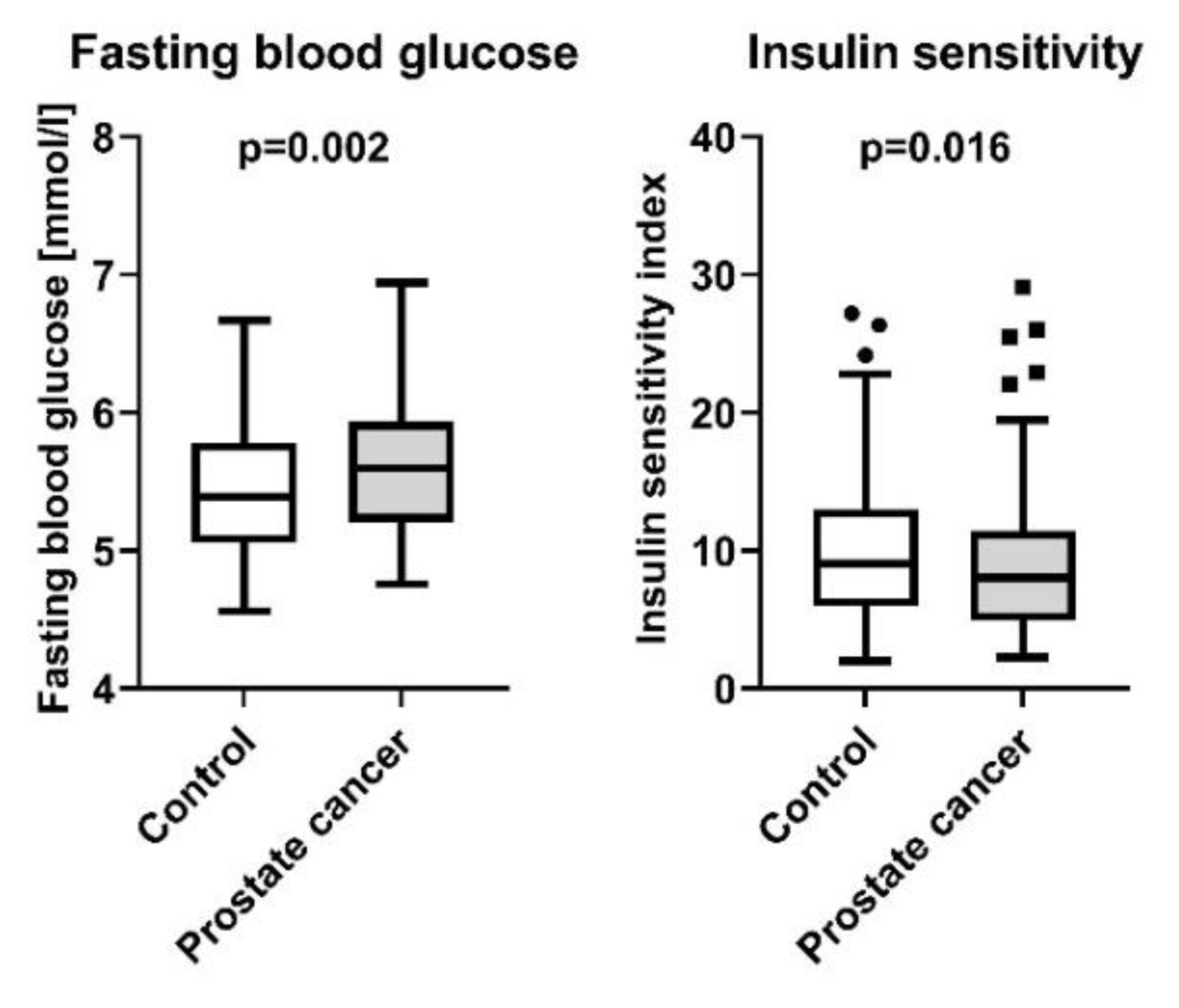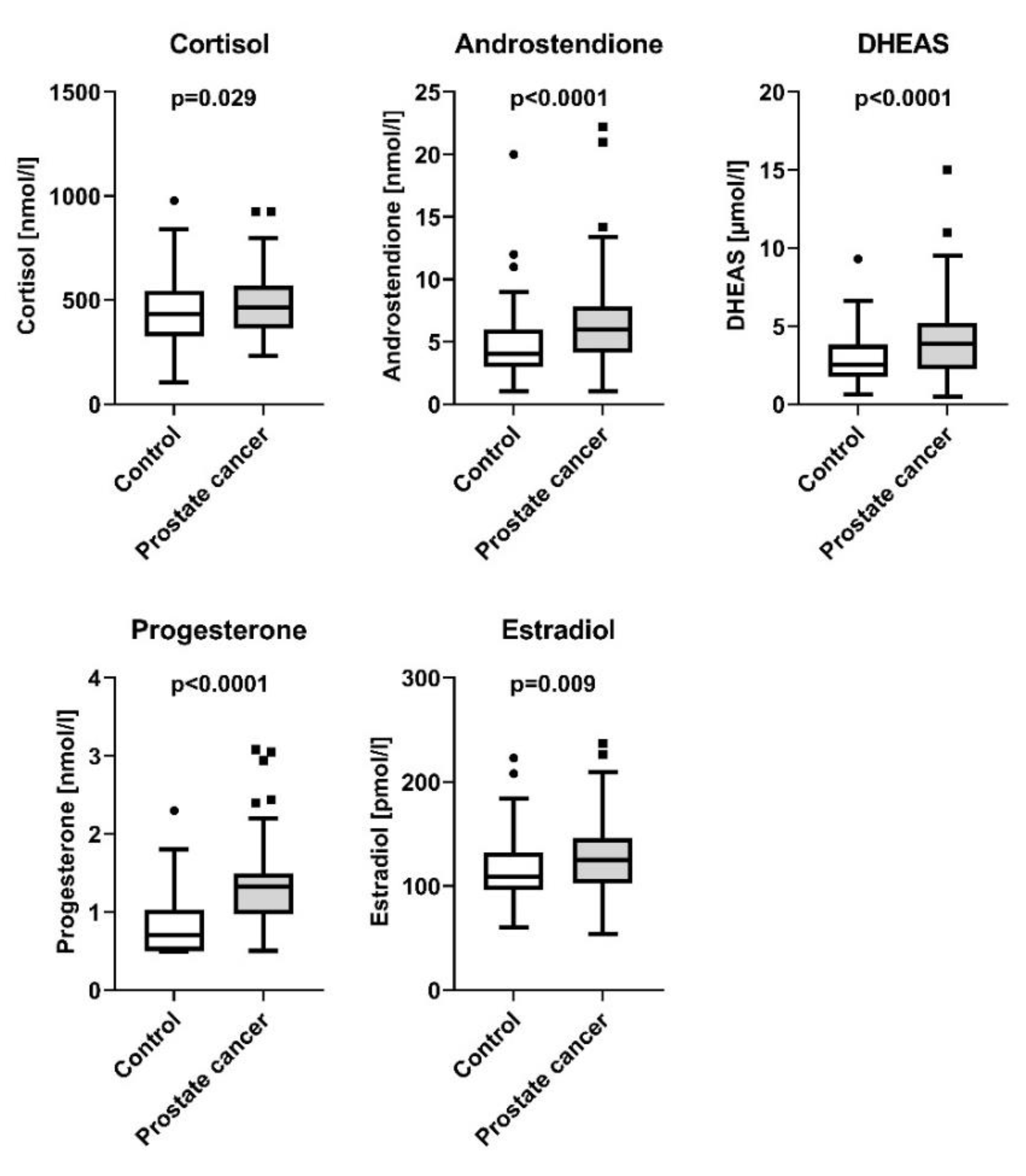Diabetes and the Prostate: Elevated Fasting Glucose, Insulin Resistance and Higher Levels of Adrenal Steroids in Prostate Cancer
Abstract
1. Introduction
2. Material and Methods
3. Results
4. Discussion
Supplementary Materials
Author Contributions
Funding
Institutional Review Board Statement
Informed Consent Statement
Data Availability Statement
Acknowledgments
Conflicts of Interest
Abbreviations
References
- Kasper, J.S.; Liu, Y.; Giovannucci, E. Diabetes mellitus and risk of prostate cancer in the health professionals follow-up study. Int. J. Cancer 2009, 124, 1398–1403. [Google Scholar] [CrossRef] [PubMed]
- Bonovas, S.; Filioussi, K.; Tsantes, A. Diabetes mellitus and risk of prostate cancer: A meta-analysis. Diabetologia 2004, 47, 1071–1078. [Google Scholar] [CrossRef] [PubMed]
- Chen, Y.; Wu, F.; Saito, E.; Lin, Y.; Song, M.; Luu, H.N.; Gupta, P.C.; Sawada, N.; Tamakoshi, A.; Shu, X.O.; et al. Association between type 2 diabetes and risk of cancer mortality: A pooled analysis of over 771,000 individuals in the Asia Cohort Consortium. Diabetologia 2017, 60, 1022–1032. [Google Scholar] [CrossRef]
- Arthur, R.; Moller, H.; Garmo, H.; Holmberg, L.; Stattin, P.; Malmstrom, H.; Lambe, M.; Hammar, N.; Walldius, G.; Robinson, D.; et al. Association between baseline serum glucose, triglycerides and total cholesterol, and prostate cancer risk categories. Cancer Med. 2016, 5, 1307–1318. [Google Scholar] [CrossRef]
- Kim, H.S.; Presti, J.C., Jr.; Aronson, W.J.; Terris, M.K.; Kane, C.J.; Amling, C.L.; Freedland, S.J. Glycemic control and prostate cancer progression: Results from the SEARCH database. Prostate 2010, 70, 1540–1546. [Google Scholar] [CrossRef]
- Wright, J.L.; Plymate, S.R.; Porter, M.P.; Gore, J.L.; Lin, D.W.; Hu, E.; Zeliadt, S.B. Hyperglycemia and prostate cancer recurrence in men treated for localized prostate cancer. Prostate Cancer Prostatic Dis. 2013, 16, 204–208. [Google Scholar] [CrossRef]
- Biernacka, K.M.; Uzoh, C.C.; Zeng, L.; Persad, R.A.; Bahl, A.; Gillatt, D.; Perks, C.M.; Holly, J.M. Hyperglycaemia-induced chemoresistance of prostate cancer cells due to IGFBP2. Endocr. Relat. Cancer 2013, 20, 741–751. [Google Scholar] [CrossRef]
- Hamilton, E.J.; Gianatti, E.; Strauss, B.J.; Wentworth, J.; Lim-Joon, D.; Bolton, D.; Zajac, J.D.; Grossmann, M. Increase in visceral and subcutaneous abdominal fat in men with prostate cancer treated with androgen deprivation therapy. Clin. Endocrinol. 2011, 74, 377–383. [Google Scholar] [CrossRef]
- Lutz, S.Z.; Todenhofer, T.; Wagner, R.; Hennenlotter, J.; Ferchl, J.M.; Scharpf, M.O.; Martus, P.; Staiger, H.; Fritsche, A.; Stenzl, A.; et al. Higher prevalence of lymph node metastasis in prostate cancer in patients with diabetes. Endocr. Relat. Cancer 2018, 25, L19–L22. [Google Scholar] [CrossRef]
- Lutz, S.Z.; Hennenlotter, J.; Scharpf, M.O.; Sailer, C.; Fritsche, L.; Schmid, V.; Kantartzis, K.; Wagner, R.; Lehmann, R.; Berti, L.; et al. Androgen receptor overexpression in prostate cancer in type 2 diabetes. Mol. Metab. 2018, 8, 158–166. [Google Scholar] [CrossRef]
- Wagner, R.; Heni, M.; Tabák, A.G.; Machann, J.; Schick, F.; Randrianarisoa, E.; de Angelis, M.H.; Birkenfeld, A.L.; Stefan, N.; Peter, A.; et al. Pathophysiology-based subphenotyping of individuals at elevated risk for type 2 diabetes. Nat. Med. 2021, 27, 49–57. [Google Scholar] [CrossRef]
- Ahrén, B.; Pacini, G. Importance of quantifying insulin secretion in relation to insulin sensitivity to accurately assess beta cell function in clinical studies. Eur. J. Endocrinol. 2004, 150, 97–104. [Google Scholar] [CrossRef] [PubMed]
- Murtola, T.J.; Vihervuori, V.J.; Lahtela, J.; Talala, K.; Taari, K.; Tammela, T.L.; Auvinen, A. Fasting blood glucose, glycaemic control and prostate cancer risk in the Finnish Randomized Study of Screening for Prostate Cancer. Br. J. Cancer 2018, 118, 1248–1254. [Google Scholar] [CrossRef] [PubMed]
- Gerlini, R.; Berti, L.; Darr, J.; Lassi, M.; Brandmaier, S.; Fritsche, L.; Scheid, F.; Bohm, A.; Konigsrainer, A.; Grallert, H.; et al. Glucose tolerance and insulin sensitivity define adipocyte transcriptional programs in human obesity. Mol. Metab. 2018, 18, 42–50. [Google Scholar] [CrossRef] [PubMed]
- Zadra, G.; Photopoulos, C.; Loda, M. The fat side of prostate cancer. Biochim. Biophys. Acta 2013, 1831, 1518–1532. [Google Scholar] [CrossRef]
- Robertson, S.; MacKenzie, S.M.; Alvarez-Madrazo, S.; Diver, L.A.; Lin, J.; Stewart, P.M.; Fraser, R.; Connell, J.M.; Davies, E. MicroRNA-24 is a novel regulator of aldosterone and cortisol production in the human adrenal cortex. Hypertension 2013, 62, 572–578. [Google Scholar] [CrossRef]
- Liu, R.S.C.; Olkhov-Mitsel, E.; Jeyapala, R.; Zhao, F.; Commisso, K.; Klotz, L.; Loblaw, A.; Liu, S.K.; Vesprini, D.; Fleshner, N.E.; et al. Assessment of Serum microRNA Biomarkers to Predict Reclassification of Prostate Cancer in Patients on Active Surveillance. J. Urol. 2018, 199, 1475–1481. [Google Scholar] [CrossRef]
- Endogenous, H.; Prostate Cancer Collaborative Group. Endogenous sex hormones and prostate cancer: A collaborative analysis of 18 prospective studies. J. Natl. Cancer Inst. 2008, 100, 170–183. [Google Scholar] [CrossRef]
- Grossmann, M.; Gianatti, E.J.; Zajac, J.D. Testosterone and type 2 diabetes. Curr. Opin. Endocrinol. Diabetes Obes. 2010, 17, 247–256. [Google Scholar] [CrossRef]
- Ding, E.L.; Song, Y.; Malik, V.S.; Liu, S. Sex differences of endogenous sex hormones and risk of type 2 diabetes: A systematic review and meta-analysis. JAMA 2006, 295, 1288–1299. [Google Scholar] [CrossRef]
- Duff, J.; McEwan, I.J. Mutation of histidine 874 in the androgen receptor ligand-binding domain leads to promiscuous ligand activation and altered p160 coactivator interactions. Mol. Endocrinol. 2005, 19, 2943–2954. [Google Scholar] [CrossRef] [PubMed]
- Grosman, H.; Fabre, B.; Mesch, V.; Lopez, M.A.; Schreier, L.; Mazza, O.; Berg, G. Lipoproteins, sex hormones and inflammatory markers in association with prostate cancer. Aging Male 2010, 13, 87–92. [Google Scholar] [CrossRef] [PubMed]
- Rahman, H.P.; Hofland, J.; Foster, P.A. In touch with your feminine side: How oestrogen metabolism impacts prostate cancer. Endocr. Relat. Cancer 2016, 23, R249–R266. [Google Scholar] [CrossRef]
- Mostaghel, E.A. Beyond T and DHT—Novel steroid derivatives capable of wild type androgen receptor activation. Int. J. Biol. Sci. 2014, 10, 602–613. [Google Scholar] [CrossRef] [PubMed]


| Control | Prostate Cancer | |||||
|---|---|---|---|---|---|---|
| Mean | SEM | Mean | SEM | p | p* | |
| Age (y) | 63.68 | 0.77 | 63.47 | 0.78 | 0.94 | - |
| BMI (kg/m2) | 26.88 | 0.33 | 26.73 | 0.34 | 0.76 | - |
| Insulin, fasting (pmol/L) | 78.09 | 4.8 | 90.84 | 4.89 | 0.004 | 0.0004 |
| C-peptide, fasting (pmol/L) | 529.07 | 22.17 | 552.5 | 22.6 | 0.28 | 0.13 |
| C-peptide, 120 min (pmol/L) | 2528.69 | 102.23 | 2366.45 | 103.71 | 0.41 | 0.45 |
| Non-esterified fatty acid (µmol/L) | 579.1 | 25.32 | 566.44 | 25.57 | 0.34 | 0.35 |
| Triglyceride (mg/dL) | 130.59 | 5.79 | 95.41 | 5.93 | <0.0001 | <0.0001 |
| Cholesterol (mg/dL) | 205.55 | 3.68 | 195.36 | 3.97 | 0.07 | 0.06 |
| HDL-cholesterol (md/dL) | 51.72 | 1.14 | 52.41 | 1.23 | 0.74 | 0.84 |
| LDL-cholesterol (ml/dL) | 123.32 | 3.29 | 118.36 | 3.55 | 0.37 | 0.36 |
| C-reactive protein (mg/dL) | 0.14 | 0.1 | 0.32 | 0.14 | 0.45 | 0.36 |
| Intrahepatic lipids (%) | 6.14 | 0.88 | 5.95 | 0.72 | 0.15 | 0.21 |
| AUC C-peptide 0–120/AUC glucose 0–120 | 261.97 | 8.05 | 267.75 | 8.25 | 0.42 | 0.66 |
| AUC C-peptide 0–30/AUC glucose 0–30 | 153.11 | 5.39 | 156.67 | 5.49 | 0.47 | 0.47 |
| Testosterone (nmol/L) | 13.06 | 0.46 | 13.28 | 0.46 | 0.98 | 0.9 |
Publisher’s Note: MDPI stays neutral with regard to jurisdictional claims in published maps and institutional affiliations. |
© 2022 by the authors. Licensee MDPI, Basel, Switzerland. This article is an open access article distributed under the terms and conditions of the Creative Commons Attribution (CC BY) license (https://creativecommons.org/licenses/by/4.0/).
Share and Cite
Lutz, S.Z.; Hennenlotter, J.; Franko, A.; Dannecker, C.; Fritsche, L.; Kantartzis, K.; Wagner, R.; Peter, A.; Stefan, N.; Fritsche, A.; et al. Diabetes and the Prostate: Elevated Fasting Glucose, Insulin Resistance and Higher Levels of Adrenal Steroids in Prostate Cancer. J. Clin. Med. 2022, 11, 6762. https://doi.org/10.3390/jcm11226762
Lutz SZ, Hennenlotter J, Franko A, Dannecker C, Fritsche L, Kantartzis K, Wagner R, Peter A, Stefan N, Fritsche A, et al. Diabetes and the Prostate: Elevated Fasting Glucose, Insulin Resistance and Higher Levels of Adrenal Steroids in Prostate Cancer. Journal of Clinical Medicine. 2022; 11(22):6762. https://doi.org/10.3390/jcm11226762
Chicago/Turabian StyleLutz, Stefan Zoltán, Jörg Hennenlotter, Andras Franko, Corinna Dannecker, Louise Fritsche, Konstantinos Kantartzis, Róbert Wagner, Andreas Peter, Norbert Stefan, Andreas Fritsche, and et al. 2022. "Diabetes and the Prostate: Elevated Fasting Glucose, Insulin Resistance and Higher Levels of Adrenal Steroids in Prostate Cancer" Journal of Clinical Medicine 11, no. 22: 6762. https://doi.org/10.3390/jcm11226762
APA StyleLutz, S. Z., Hennenlotter, J., Franko, A., Dannecker, C., Fritsche, L., Kantartzis, K., Wagner, R., Peter, A., Stefan, N., Fritsche, A., Todenhöfer, T., Stenzl, A., Häring, H.-U., & Heni, M. (2022). Diabetes and the Prostate: Elevated Fasting Glucose, Insulin Resistance and Higher Levels of Adrenal Steroids in Prostate Cancer. Journal of Clinical Medicine, 11(22), 6762. https://doi.org/10.3390/jcm11226762








